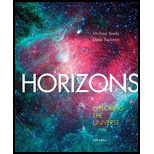
What produced the helium now present in the Sun’s atmosphere? In Jupiter’s atmosphere? In the Sun’s core?
What produced the helium now present in the atmosphere of the Sun, in Jupiter’s atmosphere and in the Sun’s core.
Answer to Problem 1RQ
The helium in the Sun’s atmosphere was produced by fusion of hydrogen to helium in the Sun’s core. Since planets were formed at the same time as the Sun, Jupiter’s atmosphere also contains Helium.
Explanation of Solution
Introduction:
The Solar Nebula theory for evolution of the Solar system rests on the following premises:
1. A rotating cloud of gas collects and flattens itself into a disc.
2. The disc becomes thinner with the Sun at the center.
3.The disc clears after the gas coalesces into planets.
The Big Bang theory presumes the Universe to have formed out of an explosion. In a few moments after Big Bang, the intense temperature, resulted in formation of protons, neutrons and electrons. The protons fused together due the prevalent high temperature to produce Helium.
A cloud of gas mainly containing Hydrogen and Helium stars to collect and rotate about an axis. The cloud of gas flattens itself into a thin disc with the Sun at the center. The gas in the disc coalesces into planets.
The Solar system was formed at the same time as the Sun. Hence the core of the Sun contains Helium formed by fusion of protons. The atmosphere of the Sun contains the same elements present in the Sun’s core. The planets were formed at the same time as the Sun. Hence Jupiter’s atmosphere also contains Helium. Helium is retained in the atmosphere of Jupiter due to its great gravitational force.
Conclusion:
Thus, the helium in the Sun’s atmosphere was produced by fusion of hydrogen to helium in the Sun’s core and since planets were formed at the same time as the Sun, Jupiter’s atmosphere also contains Helium.
Want to see more full solutions like this?
Chapter 15 Solutions
Horizons: Exploring the Universe (MindTap Course List)
- A new Terrestrial planet has been discovered orbiting a nearby Sun-like star. Astronomers have obtained spectra of this planet and determined that the atmosphere is composed of roughly 99% CO2, and the remaining 1% is mostly N2 and is very thin compared to Earth's atmosphere. Briefly describe how the planet could have developed such an atmosphere.arrow_forwardConsider the greenhouse effect in an atmosphere model consisting of two infrared-opaque layers. Find the temperatures of both layers and the temperature of the planet's surface.arrow_forwardThe fraction of the energy flux received which is reflected into space is the albedo of Venus, av, which is about 0.76. The fraction of the energy flux which is absorbed is then (1-av) = 1. - 0.76 = 0.24. So the amount of energy actually absorbed by Venus in each second is Lv = (1-av)Ev. Lv = (1-av)Ev = ___________________ ergs/s And next calculate the effective temperature of Venus: Tv4 = (Lv/(4pdv2))/s = Lv/(4spdv2) = __________________ K4 and taking the square root of Tv4 twice in succession we get the effective Temperature Tv: Tv = [Lv/(4spdv2)]0.25 = _________________ K Calculate Venus' emittance assuming that the Venus' actual temperature, Tvr, is 472o C = 745 K: ev = Lv/(4pdv2s Tvr4) = __________________ .arrow_forward
- Under what conditions can the outer surface of a vertical cylinder be treated as a vertical plate in natural convection calculations?arrow_forwardWhat allows moons of Jupiter and Saturn to have liquid interiors?arrow_forwardDo you think the Moon could retain an atmosphere of nitrogen for the age of the Solar System? Explain why or why notarrow_forward
- Pure, solid water ice has an albedo A≈0.35. What is the minimum distance from the Sun at which a rapidly rotating ice cube would remain frozen? Between which two planets does this distance lie?arrow_forwardGusts of the solar wind travel as fast as 1000 km/s. How many days would the solar wind take to reach Earth at this speed? (Note: The average distance to the Sun is 1.496 ✕ 108 km.)arrow_forwardCalculate the pressure p of the Venus atmosphere (it consists of CO2 at 477oC) at the height of 1 km from the planet surface, where p0=9.3 MPa. The planet mass is 4.9x1024 kg, its radius is 6050 kmarrow_forward
- What are The Magellanic Clouds?arrow_forwardWhat produced the helium present in Jupiters atmosphere and inside Sun's core ?arrow_forwardAccording to http://hyperphysics.phy-str.gsu.edu/hbase/solar/venusenv.html, the atmosphere of Venus is approximately 96.5% CO2 and 3.5% N2 by volume. On the surface, where the temperature is about 750 K and the pressure is about 90 atm, what is the density of the atmosphere?arrow_forward
 Horizons: Exploring the Universe (MindTap Course ...PhysicsISBN:9781305960961Author:Michael A. Seeds, Dana BackmanPublisher:Cengage Learning
Horizons: Exploring the Universe (MindTap Course ...PhysicsISBN:9781305960961Author:Michael A. Seeds, Dana BackmanPublisher:Cengage Learning
 Foundations of Astronomy (MindTap Course List)PhysicsISBN:9781337399920Author:Michael A. Seeds, Dana BackmanPublisher:Cengage Learning
Foundations of Astronomy (MindTap Course List)PhysicsISBN:9781337399920Author:Michael A. Seeds, Dana BackmanPublisher:Cengage Learning AstronomyPhysicsISBN:9781938168284Author:Andrew Fraknoi; David Morrison; Sidney C. WolffPublisher:OpenStax
AstronomyPhysicsISBN:9781938168284Author:Andrew Fraknoi; David Morrison; Sidney C. WolffPublisher:OpenStax Stars and Galaxies (MindTap Course List)PhysicsISBN:9781337399944Author:Michael A. SeedsPublisher:Cengage Learning
Stars and Galaxies (MindTap Course List)PhysicsISBN:9781337399944Author:Michael A. SeedsPublisher:Cengage Learning





